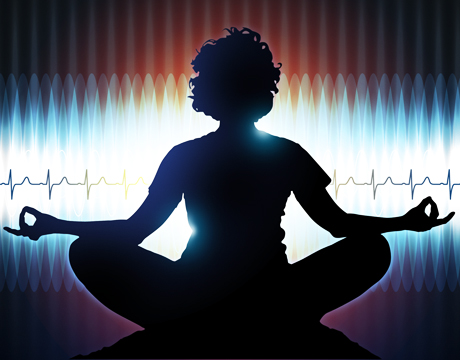Engineering Enlightenment
Engineering Enlightenment


Some spend a few decades meditating. Others spend an indeterminate amount of time inquiring after their true selves. Still others ingest ayahuasca or other intense psychoactive drugs. All are seeking the same thing: in a word, enlightenment. Now, a robotics engineer out of California is hoping to help seekers find it another way: with technology.
After receiving his M.S. from MIT in the Personal Robots Group, things were going swimmingly for Mikey Siegel. He’d found a stimulating, high-paying job in Silicon Valley, had a rich social life. And yet he was still dogged by a nagging “fundamental sense of not being OK,” as he puts it. “I was trying to figure out what’s next. My original conception was that it would be a new job, or new set of circumstances, some change in external conditions. What I ended up realizing was that what I was looking for was independent of conditions. One could suffer in any configuration.”
He left for the East, met yogis and gurus, visited ashrams, and went on mediation retreats. At one of these, during a 14-hour mediation, he had an experience that made him feel more clear and present than he had ever felt before. While it lasted, he felt none of the pain that had assaulted his back and legs during the long sitting. Or, to put more precisely, he felt the pain, but it no longer bothered him.
He returned to the ordinary world, and the U.S., determined to put his technological skills to use helping others to have an experience something like his own. “My fundamental goal is really the eradication of human suffering, from the inside out,” he says. “I see it as a real possibility. I know it’s possible for individuals and I want to make that as available as humanly possibly.”
Siegel went to The Hong Kong Polytechnic University to study with the director of Digital Entertainment and Game Development, Gino Yu, whose focus is on technologies that “provoke personal growth and inner exploration,” as his website puts it. With Yu, Siegel explored every possibly technology that might turn the mind in on itself, or get it out of the way. Subsequently, he became Director of Consciousness Engineering at the Center for the Study of Non-Symbolic Consciousness and started his own company, BioFluent.
Under the BioFluent banner, Siegel created three products to help induce meditative states in their users. They’re not unlike the biofeedback gadgets of the Sixties and Seventies that, Siegel believes, were unfairly maligned—and left largely unexplored—for attracting “fringe interests that didn’t mix with academia.” The principle is simple: “Set up a visual or auditory feedback loop and you can teach people to change things anywhere in their bodies.”
Siegel’s first attempt at creating such a loop capitalized on research, out of the University of California, that showed that the heart rates of two well-acquainted individuals staring at each other would quickly synchronize. HeartSync measures the heart rates of a group of users and translates that into sound and visuals. As the members of the group begin to see how their internal state affects the a.v., their beats become more regular and eventually thump as one. The perceptual experience affects their hearts and their hearts change the perceptual experience.
The Nome (an “anti-distraction machine”) is like HeartSync, but for the individual. In this case, the users wear EEG sensors, sensors that gauge electrical activity in muscles, and a heart rate sensor. The data from these sensors can be programmed to change the visual patterns that appear on a small, phone-sized box. The result is something like the iTunes Visualizer, but where the user’s vital signs make the image, rather than music.
That same data set can also be used to create music, and this is where Siegel’s own heart is at the moment. HearNow is a device that measures your brain wave and pulse as you listen to music. Then it turns around and uses those to alter the music. Using tunes from a wide swath of genres (“not just esoteric grad student music”) the listener can guide themselves to meditative states. “You define a data space of interest based on what you measure from the brain. You basically map that in a consistent way to sound. People go about their day and listen to their own conscious experience.”
“If you’re stressed out and you know what calmness sounds like, you can guide yourself there,” says Siegel. “You also know your unique path to get there, but that path is a composition. That music becomes very meaningful to you, for how you get you self form one state to another.” With the tool, Siegel learned to change the speed of his heart rate.
To mystics who might balk at the thought of a spiritual gadget, Siegel points out that his tools are only the latest in a long line of technological advancements for guiding seekers through the gateless gate.
“There are reliable, highly evolved, scientifically structured methods to achieve that,” says Siegel. “There are many from across disciplines, across thousands of years, to modern versions. Those were technologies for understanding the nature of the mind. Buddhists and yogis are basically scientists and engineers that have created conceptual tools to change our relationship to ourselves and reality, which are arguably the same thing."
“From that understanding, it just was a natural extension to think about tangible technologies.”
Michael Abrams is an independent writer.
Buddhists and yogis are basically scientists and engineers that have created conceptual tools to change our relationship to ourselves and reality, which are arguably the same thing.Mikey Siegel, founder, BioFluent




.png?width=854&height=480&ext=.png)


